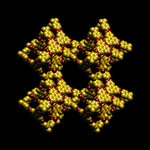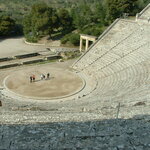Applied Physics

Chemists at UCLA have designed new organic structures for the storage of voluminous amounts of gases for use in alternative energy technologies.
The research, to be published on April 13 in the journal Science, demonstrates how the design principles of reticular chemistry have been used to create three-dimensional covalent organic frameworks, which are entirely constructed from strong covalent bonds and have high thermal stability, high surface areas and extremely low densities.
The image shows the crystal structure of COF-108. Synthesized only from light elements (H,B,C,O) COF-108 is the…
John Hauptman stood before an international gathering of particle physicists and announced he had another idea.
One that was different. One that was simpler. And best of all, one that he was sure would work.
The 4th Concept detector would eliminate the iron surrounding most particle detectors and would be about one-tenth the mass of other detectors. Credit: Iowa State University
It was the August 2005 meeting of the physicists working and hoping to create the next huge thing in particle physics, the International Linear Collider. As proposed, the collider would be about 19 miles long and…

The powerful earthquake struck suddenly, shaking the seven-story building so hard it bent, cracked and swayed in response.
But this was no ordinary earthquake. In a groundbreaking series of tests, engineering researchers from UC San Diego's Jacobs School of Engineering jarred a full-size 275-ton building erected on a shake table, duplicating ground motions recorded during the January 17, 1994 1994 Northridge earthquake in Los Angeles, California.
Movies created by SDSC visualization experts using data from a sensor-equipped building give UCSD engineers a powerful tool to explore structure…
Two of the world's worst natural disasters in recent years stemmed from different causes on opposite sides of the globe, but actually had much in common, according to researchers who are part of a large National Science Foundation-funded research initiative that has been studying both the Indian Ocean Tsunami of 2004 and the Hurricane Katrina of 2005.
As a storm surge recedes, the sudden decrease in downward pressure on the saturated soil causes the sand to liquefy and to flow out like a heavy slurry. This can result in giant potholes like this 6 foot-deep one on the coastal highway.…

Female stem cells derived from muscle have a greater ability to regenerate skeletal muscle tissue than male cells, according to a study at Children’s Hospital of Pittsburgh of UPMC.
The study, which is being published in the April 9 issue of the Journal of Cell Biology, is the first ever to report a difference in regenerative capabilities of muscle stem cells based on sex.
This finding could have a major impact on the successful development of stem cells as viable therapies for a variety of diseases and conditions, according to the study’s senior author, Johnny Huard, PhD, director of the…

Synovial fluid is slime with a serious purpose: Protecting shoulders, hips and other joints from wear, reducing the likelihood of injuries and arthritis.
Scientists have long believed that synovial fluid gets its surface-slicking, shock-absorbing properties from the "goo molecule" hyaluronate. But new research led by Brown University physician and engineer Gregory Jay, M.D., shows that the protein lubricin is also a player, not only lubricating cartilage but also giving synovial fluid its spring.
"Protein components like lubricin are just as key as hyaluronate for protecting joints," Jay…

Flexible electronic membranes may overcome a longstanding dilemma faced by brain researchers: How to replicate injuries in the lab without destroying the electrodes that monitor how brain cells respond to physical trauma.
Developed by a team of engineers at Princeton University, Columbia University and the University of Cambridge, the membranes feature microelectrodes that are able to withstand the sudden stretching that is used to simulate severe head trauma. The systems could allow far more nuanced studies of brain injury than previously possible and may lead to better treatments in the…

Researchers at Johns Hopkins have discovered how cells fine-tune their oxygen use to make do with whatever amount is available at the moment.
Too little oxygen threatens life by compromising mitochondria that power it, so when oxygen is scarce, cells appear to adjust by replacing one protein with an energy-efficient substitute that "is specialized to keep the motor running smoothly even as it begins to run out of gas," says Gregg Semenza, M.D., Ph.D., a professor of pediatrics and director of the vascular biology program in the Institute for Cell Engineering at Hopkins. "This is one way that…

As the ancient Greeks were placing the last few stones on the magnificent theater at Epidaurus in the fourth century B.C., they couldn’t have known that they had unwittingly created a sophisticated acoustic filter. But when audiences in the back row were able to hear music and voices with amazing clarity (well before any theater had the luxury of a sound system), the Greeks must have known that they had done something very right because they made many attempts to duplicate Epidaurus’ design, but never with the same success.
The Theater at Epidaurus on the Peloponnese in Greece
Researchers…

On a Greek mountainside, sensors in the walls of a high-tech villa will record stresses and vibrations, temperature and humidity levels. Nothing out of the ordinary there. But it will also have special walls made from nano-polymer particles that will turn into a liquid under pressure, flow into the cracks, and harden again.
German building manufacturer Knauf is the lead contractor behind the project and the interesting use of nano-polymer particles by the University of Leeds School of Mechanical Engineering.
Professor Anne Neville said about the future implications of this technology, "Once…